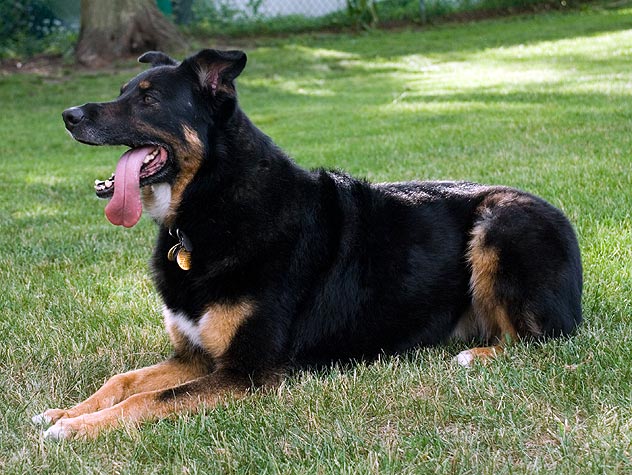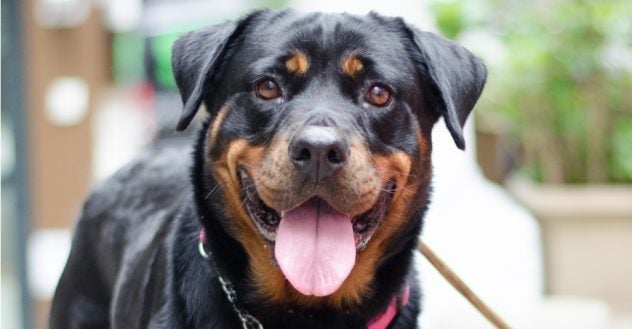Bullmastiff
Bullmastiffs boast a surprising duality: fearless at work and docile at home. Undeniably large, their imposing stature is softened by their loving and loyal nature. Their intelligence and unwavering confidence are reflected in their broad heads with dark eyes, V-shaped ears, and deep muzzles. Their short, dense coat comes in fawn, red, or brindle, while their powerful build showcases a combination of strength, endurance, and agility.
Breed characteristics carousel
Learn More
Need to Know
- Suitable for experienced owners
- Extra training required
- Potential health issues
- Enjoys vigorous walks
- Large dog
- Some drool
- Requires regular grooming
- Chatty and vocal dog
- Barks, alerts, and may be physically protective/suspicious of visitors
- Could have issues with unknown dogs but gets along with known dogs
- May need additional training to live with other pets
- May need additional supervision to live with children
- Needs a large yard, either in suburban or rural areas
- Can be left alone with training
- AKC Registered Breed

Personality
The Bullmastiff's personality is a mix of loyalty, protectiveness, and surprising gentleness given their size. These devoted companions are fiercely dedicated to their families, acting as watchful guardians without intense barking. New visitors are typically greeted with suspicion, and only those introduced by a trusted family member might be accepted. Despite their tough appearance, Bullmastiffs are known for their calmness and quiet demeanor. They are not easily fazed, but their bravery is undeniable when threatened.
The Bullmastiff's nickname, "The Gamekeeper's Night Dog," is a nod to its origin, as they were once used in England to catch poachers in the 1800s. Their name and breed combine the Bulldog and the Mastiff, a powerful protector that’s both intimidating and controllable. Trainable and with a subdue-rather-than-attack temperament, the Bullmastiff became a gamekeeper's trusted companion. They’ve since morphed into a trusted and loyal companion dog.
The Bullmastiff's ideal owner is someone who possesses a healthy dose of humor and patience. These loveable goofballs often see themselves as lapdogs and might resist exercise, especially if they can convince you to become a cozy doggy bed on a rainy day. Motivational skills will come in handy to keep them active and healthy. Because Bullmastiffs can be wary of strangers and other dogs, their owners should be enthusiastic about training and socialization. This commitment helps ensure a well-adjusted Bullmastiff who feels comfortable and confident when encountering new people and furry friends.
Bullmastiffs require moderate exercise, but it's important to be mindful of their age. While daily walks and playtime are important for adults, excessive exercise, jumping, or stairs should be avoided until they are at least a year old to prevent potential bone and joint problems later in life. Shorter walks and supervised outdoor time are ideal for puppies. As adults, a brisk walk (they’re not the best jogging buddies) or outdoor play session for about an hour a day will keep them happy and content. Their size and strength do require a securely fenced yard for safe outdoor adventures.
Due to their large size, Bullmastiffs are best suited for homes with ample space. A large house provides enough room for them to move around comfortably, while a securely fenced garden allows them to enjoy the outdoors safely. When designing your outdoor space, consider how visitors and deliveries will access the front door, as you might need to create a separate pathway to avoid unexpected encounters with your Bullmastiff.
The Bullmastiff's short coat is a blessing for busy dog owners. Brushing with a grooming mitt at least once a week is typically all that's needed to remove loose hair and keep their coat healthy. Regular brushing helps manage shedding, and baths should only be given when necessary. Keeping an eye on their skin and coat for signs of dryness or oiliness is important, as these could be linked to dietary issues or allergies.
Owning a Bullmastiff requires a commitment to training. Their independent streak means traditional obedience might not be their forte, but leash and harness training is crucial for safe walks with this powerful breed. While their protectiveness is valued, it needs to be managed through positive exposure to people and animals. The good news is that Bullmastiffs are intelligent and can excel in various activities, making training a fun and rewarding way to build a strong bond with your furry friend.
While Bullmastiffs are friendly with their loved ones, their protectiveness and suspicion of strangers can be a concern. Their size and strength necessitate careful supervision, especially with young children. Additionally, their playfulness might sometimes be misinterpreted as roughhousing, potentially leading to unintentional harm. Therefore, Bullmastiffs might be a better fit for families with older, dog-savvy teenagers who can provide the training and socialization these dogs need to thrive.
The cost of a Bullmastiff from a breeder is significantly more than the cost of adopting one from a local shelter or rescue. The adoption fee usually covers additional items such as spaying or neutering, vaccines, and microchipping.

Learn more about feeding and caring for your Bullmastiff on Purina.
Did You Know?
- The most famous Bullmastiff was likely Sylvester Stallone’s dog, Butkus. He adopted him at six weeks old and used him in the film Rocky because he couldn’t afford a trained stunt dog.
- Unlike many guard dogs, Bullmastiffs were trained to be silent protectors. Their job was to track poachers silently and apprehend them, not to raise an alarm. This tendency toward quiet alertness persists in many Bullmastiffs today.




